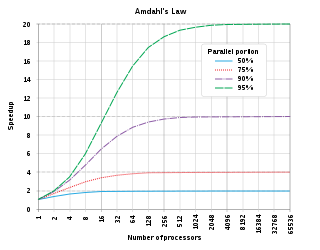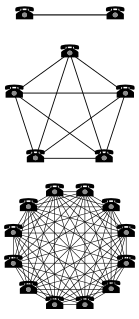 W
WIn computer architecture, Amdahl's law is a formula which gives the theoretical speedup in latency of the execution of a task at fixed workload that can be expected of a system whose resources are improved. It is named after computer scientist Gene Amdahl, and was presented at the AFIPS Spring Joint Computer Conference in 1967.
 W
WIn computer architecture, Gustafson's law gives the theoretical speedup in latency of the execution of a task at fixed execution time that can be expected of a system whose resources are improved. It is named after computer scientist John L. Gustafson and his colleague Edwin H. Barsis, and was presented in the article Reevaluating Amdahl's Law in 1988.
 W
WHaitz's law is an observation and forecast about the steady improvement, over many years, of light-emitting diodes (LEDs).
 W
WHuang's Law is an observation in computer science and engineering that advancements in graphics processing units (GPU) are growing at a rate much faster than with traditional central processing units (CPU). The observation is in contrast to Moore's law that predicted the number of transistors in a dense integrated circuit (IC) doubles about every two years. Huang's law states that the performance of GPUs will more than double every two years. The hypothesis is subject to questions about its validity.
 W
WSimply stated, Klaiber's law proposes that "the silicon wafer size will dictate the largest diameter of ultrapure water supply piping needed within a semiconductor wafer factory."
 W
WKoomey's law describes a trend in the history of computing hardware: for about a half-century, the number of computations per joule of energy dissipated doubled about every 1.57 years. Professor Jonathan Koomey described the trend in a 2010 paper in which he wrote that "at a fixed computing load, the amount of battery you need will fall by a factor of two every year and a half."
 W
WMetcalfe's law states that the value of a telecommunications network is proportional to the square of the number of connected users of the system (n2). First formulated in this form by George Gilder in 1993, and attributed to Robert Metcalfe in regard to Ethernet, Metcalfe's law was originally presented, c. 1980, not in terms of users, but rather of "compatible communicating devices". Only later with the globalization of the Internet did this law carry over to users and networks as its original intent was to describe Ethernet connections.
 W
WMoore's law is the observation that the number of transistors in a dense integrated circuit (IC) doubles about every two years. Moore's law is an observation and projection of a historical trend. Rather than a law of physics, it is an empirical relationship linked to gains from experience in production.